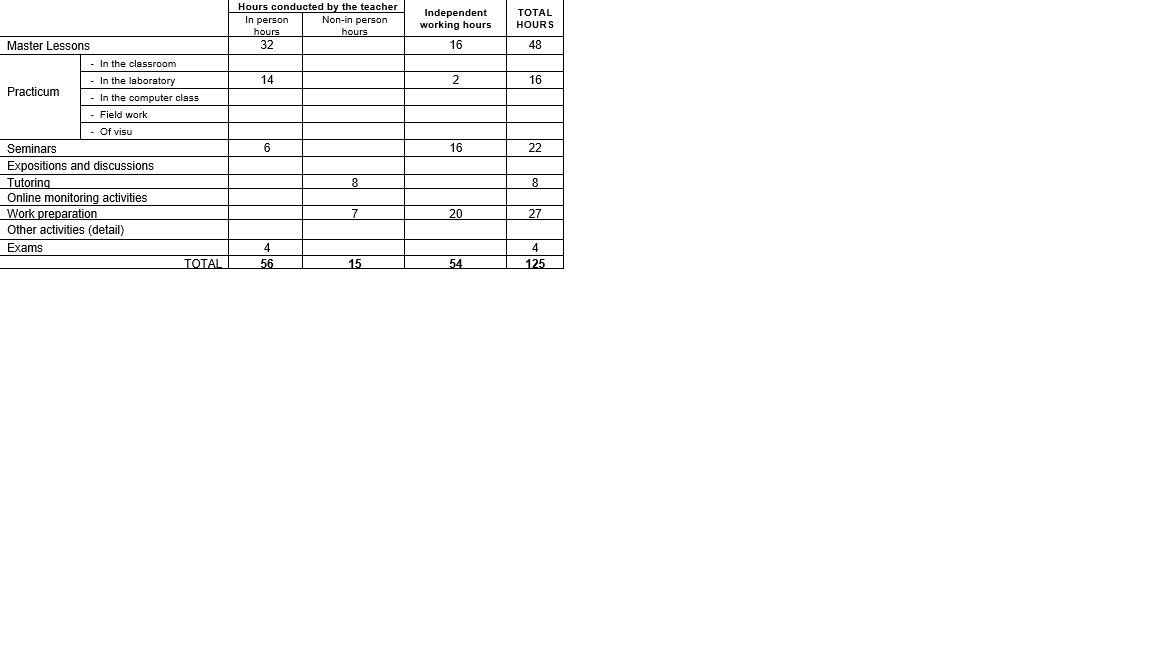CELL SIGNALING IN CANCER
GRADO EN FARMACIA
Curso 2022/2023
1. Datos de la asignatura
(Fecha última modificación: 08-06-22 13:56)- Código
- 100166
- Plan
- 201
- ECTS
- 5.00
- Carácter
- OPTATIVA
- Curso
- 4
- Periodicidad
- Segundo cuatrimestre
- Idioma
- ESPAÑOL
- Área
- MEDICINA
- Departamento
- Medicina
- Plataforma Virtual
Campus Virtual de la Universidad de Salamanca
URL de Acceso: The indicated by the teacher and https://studium.usal.es
Datos del profesorado
- Coordinador/Coordinadora
- María Carmen Guerrero Arroyo
- Grupo/s
- 1
- Centro
- Fac. Medicina
- Departamento
- Medicina
- Área
- Medicina
- Despacho
- Centro de Investigación del Cáncer (CIC), laboratorio 17
- Horario de tutorías
- Monday to Friday. 12 to 14 h
- URL Web
- https://produccioncientifica.usal.es/investigadores/56798/detalle
- cguerrero@usal.es
- Teléfono
- 923 294 500 Ext. 4817
2. Sentido de la materia en el plan de estudios
Bloque formativo al que pertenece la materia.
AREA III: BIOLOGY
Linked courses: Biochemistry I, Biochemistry II, Biochemistry III, Molecular Biology
Papel de la asignatura.
Knowing the main signaling mechanisms and their components is essential to understand the physiological alterations in cells that lead to cancer and other pathologies. In the last 20-30 years, discoveries in this field have experienced an exponential progression, which justifies the teaching of this matter as a specific subject. Cell Signaling in Cancer constitutes a subject complementary to others imparted in the Grade of Pharmacy, such as Biochemistry, Molecular Biology and Physiology. In addition, to know the signaling mechanisms of cells is essential for those students who want to follow a scientific career in Biomedicine.
Perfil profesional.
This course provides the knowledge to understand, at a molecular level, the mechanisms involved in the physiology of the cell, which are responsible for its correct homeostasis, as well as the alterations in these mechanims that might derive in a pathological phenotype. The course provides also knowledge for the practice of biomedical research and the development of activities in the following fields:
- Industry and Distribution
- Analysis and Public Health
- Research and Teaching
3. Recomendaciones previas
The students must have basic knowledge in Biochemistry, Molecular Biology, Cell Biology and Genetics. Therefore, they must have passed the courses: “Biology”, imparted in first year and the three “Biochemistry” courses, imparted in first and second years.
4. Objetivo de la asignatura
- To get a general view of the signaling mechanisms developed by cells from pluricelular organisms to communicate themselves and with their environment.
- To know the main signaling transduction pathways at a physiological and pathological level.
- To know the role of the main extracellular molecules, receptors, second messengers and intracellular proteins involved in these processes.
- To be able to describe the main signaling pathways, the components involved, their regulatory mechanisms and the pathological implications of their disfunction with emphasis in the tumoral processes.
- To know the main techniques and models used in cell signaling research.
- To get a basic knowledge about the participation of the main signaling pathways in biological processes, such as proliferation and cell death, differentiation, response to hypoxia and to reactive oxygen species (ROS), adhesion and cell migration, etc. and their relationship with the tumoral disease.
- To learn how to write an experimental report.
- To learn how to discuss a scientific paper.
5. Contenidos
Teoría.
LESSON 1. Organization of the plasma membrane and its involvement in cell signaling
Protein and lipid composition of the plasma membrane and its organization in microdomains. Caveolae and lipid rafts. Alterations in cancer.
LESSON 2. Membrane receptors I. Types. Family Erb/HER.
Principal tyrosine kinase receptors. Structure and regulation of Erb/HER receptors. Receptor mutations in cancer.
LESSON 3. Membrane receptors II. Non-receptor tyrosine kinases.
Non-receptor tyrosine kinases: Src family. Signaling modules (SH2 and SH3 domains). Involvement in cancer.
LESSON 4. GPCR and Heterotrimeric G proteins: structure and activation.
G-protein coupled receptors (GPCR). Families Gq, Gi, G12/13, Gs. cAMP and cGMP as second messengers. Cellular responses mediated by cAMP and cGMP. The PKA pathway.
LESSON 5. Phospholipases and protein kinase C. Signaling domains.
PLA2 and PLC families of phospholipases. PKC protein families. Adaptor proteins and second messengers (DAG, PIP2, IP3).
LESSON 6. Small GTPases. Structure, processing and regulation I. Ras family.
Superfamily of Ras proteins, classification. Structure of Ras proteins and post-translational modifications. Regulation by GEFs and GAPs.
Main functions of Ras and Rap; involvement in tumoral processes. Germline Ras mutations: Noonan and Costello syndromes.
LESSON 7. Small GTPases. Structure, processing and regulation II. Rho family.
Rho family of GTPases. Regulation by GEFs, GAPs and GDIs. Main functions of Rho proteins: regulation of actin cytoskeleton. Implication in tumoral processes and other pathologies.
LESSON 8. MAPKs pathways.
MAPK families: ERK, p38 and JNK proteins. Regulation by phosphatases. Regulation by scaffold proteins. Agonists and inhibitors of the MAPK pathways. MAPKs in cancer.
LESSON 9. Lipid kinases: involvement in survival.
PI3K family and survival pathways. Regulation by phosphatases (PTEN). PI3K-Akt-mTor pathways in the regulation of mRNA translation. PI3K pathway and cancer.
LESSON 10. Calcium-mediated signaling.
Calcium as an intracellular messenger. Calcium receptors and calmodulin. Cellular calcium stores. Platelets, skeletal muscle and neurons as models of signaling by calcium.
LESSON 11. Signaling by hypoxia and reactive oxygen species (ROS).
Role of ROS in the regulation of signaling transduction and gene expression. Regulation of NADPH oxidases. Carcinogenesis by ROS. Hypoxia and tumor angiogenesis.
LESSON 12. Nuclear receptors and transcription factors. NFkB and JAK-STAT pathways.
Classification and general characteristics of the nuclear receptors-coupled signaling. JAK/STAT pathway. The NFkB pathway: interconnection between inflammation and cancer.
LESSON 13. Wnt and Notch pathways.
Regulation of cell polarity by the Wnt pathway. Mutations in cancer: colorectal adenocarcinoma as model. Role of vitamin D. The Notch pathway in the embryonic development. Deregulation in cancer.
LESSON 14. Cell death: apoptosis and autophagy pathways.
Extrinsic pathway (death receptors). Intrinsic pathway. Bcl-family of proteins. Caspases. Role of p38MAPKs.
LESSON 15. Adhesion and migration: cytoskeleton and focal adhesions proteins.
Cytoskeleton structures. Adhesion receptors (integrins). Actin polymerization and formation of adhesion and migration structures. Deregulation of adhesion and migration in metastasis.
LESSON 16. Cell cycle regulation.
Cell cycle phases. Cyclins and CDKs. CDKs inhibitors: INK4 family, CIP/KIP family. Retinoblastoma. P53. Cell cycle Checkpoints. Implications in DNA damage response.
LESSON 17. Cellular differentiation.
Differentiation versus proliferation. The hematopoietic lineage as a model. Epigenetics. Cancer stem cells.
LESSON 18. DNA damage repair. DNA repair pathways as targets for cancer therapy.
Types of DNA damage and DNA damage agents. Role of p53. Principal repair mechanisms: ATM and ATR pathways. Deregulation of the DNA damage response in cancer.
6. Competencias a adquirir
Básicas / Generales.
GC-1: Handling theoretical contents
GC-2: Handling methodology
GC-3: Basic abilities on information technologies
GC-4: Team work
GC-5: Ethics and moral integrity
Específicas.
EC-1: Skill competences: Ability to design experimental approaches to monitorize the activity of signaling pathways. Ability to present and discuss a scientific paper. Ability to perform standard techniques requiered in cell biology research.
EC-2: Knowledge competences: To know the principal mechanisms that regulate cell growth, cell differentiation and malignant transformation.
EC-3: Attitude competences: imagination, personal effort and colaboration within a team.
EC-4: To understand, write and be able to express in English.
EC-5: Handling bibliography data bases
Transversales.
TC-1: Instrumental: Troubleshooting. Decision making.
TC-2: Personal: Ability for criticism and self-criticism.
TC-3: Systemic: Ability to adapt to new situations.
7. Metodologías
Theoretical contents (18+1 lessons distributed in 32 master classes)
Practical contents:
- Laboratory practicum: 1. Monitoring activation of ERK/MAPK pathway in HEK-293T cells stimulated with 20% serum at different time points. 2. Monitoring apoptosis caused by osmotic stress, serum deprivation and oxidative stress in HEK-293T cells. 3. Analysis of cell cycle phases in synchronous and asynchronous cell cultures. 4. Analysis in vivo, by fluorescence microscopy, of the ectopic expression of proteins in HEK-293T cells transfected with a plasmid containing GFP (green fluorescent protein).
- Seminars: Extension of the lessons contents.
8. Previsión de Técnicas (Estrategias) Docentes

9. Recursos
Libros de consulta para el alumno.
Alberts, B. et al. Molecular Biology of the Cell (Fifth Edition). Garland Science, 2007
Lodish, H. et al. Molecular Cell Biology (Sixth Edition). Scientific American Books, 2007
Pollard TD, Earnshaw WC. Cell Biology (Second Edition). Elsevier, 2007
John Nelson. Structure and Function in Cell Signaling. John Wiley & Sons Ltd, 2008
Otras referencias bibliográficas, electrónicas o cualquier otro tipo de recurso.
Nature Reviews Journal (Molecular Cell Biology, Drug Discovery, Cancer, etc.)
The Signaling Gateway: http://www.signaling-gateway.org
Recomended web-pages: Journals specialized in signaling transduction.
10. Evaluación
Consideraciones generales.
Laboratory practicum:
- Mandatory attendance to laboratory practicum (neccesary conditions to pass the matter).
- Test questions about the practicum in the exam
Seminars
- Mandatory peformance of announced seminars (neccesary conditions to pass the matter).
Continuous evaluation:
- Participation in theoretical classes and seminars.
Global evaluation proof about the competences to be adquired in the course
It will deal with the contents of the theoretical classes, seminars and, in general, with the competences to achieve. It will last 2-3 hours.
Criterios de evaluación.
To pass the matter it will be necessary:
To get a qualification equal or superior to five, applying the criteria specified below:
The global qualification will be obtain by calculating the weighted average following these criteria:
1. Continuous evaluation: 5%
- Participation in the master classes and seminars.
2. Preparation and exposition of seminars: 20%
3. Laboratory practicum: 15%
- Performing of laboratory work
- Interest and comprehension of the lab work
- Specific questions in the test exam
4. *Global evaluation test of the competences to be adquired in the course 60%.
- 40 Multiple Choice Questions: 60%
- 2 Short Questions: 40%
*1, 2, 3 will be added to 4, only if the exam score is >5
Instrumentos de evaluación.
Described in the above section.
Recomendaciones para la evaluación.
Study, consult of questions, handling of bibliographic resources (books and internet), team work.
Recomendaciones para la recuperación.
Practicum:
- It is not repeated in the next course.
- There is a possibility to improve the qualification of the practicum in the following courses by performing a new written test about the content of the practicum.
Extraordinary Call: Evaluation
The global qualification will be obtain by calculating the weighted average following these criteria:
1. Continuous evaluation: 5%
- Participation in the master classes and seminars.
2. Preparation and exposition of seminars: 20%
3. Laboratory practicum: 15%
- Performing of laboratory work
- Interest and comprehension of the lab work
- Specific questions in the test exam
4. Global evaluation test of the competences to be acquired in the course 60%


